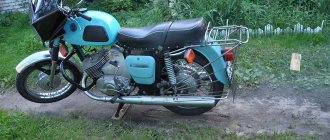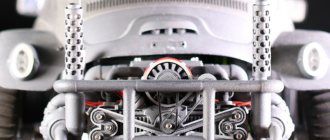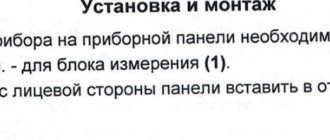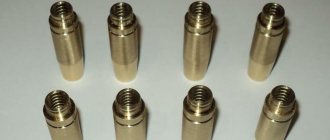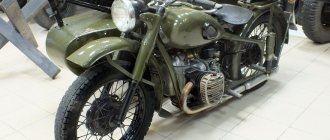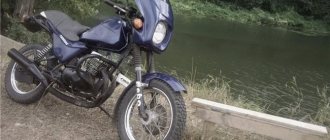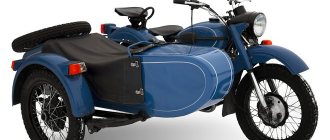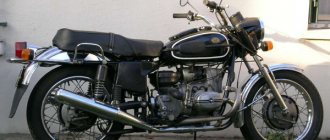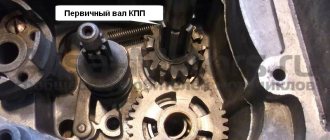Moto engine and forced cooling
As you know, any all-terrain vehicle with a motorcycle engine simply requires forced cooling. Since engines on a motorcycle periodically overheat in hot weather, and even more so when installed on an all-terrain vehicle with lower speeds and often higher loads.
On homemade all-terrain vehicles you can find engines from motorcycles : 1) Izh-Planet - common on light caracats 2) Ural , Dnepr - more powerful engines for heavy swamp vehicles 3) Izh-Jupiter - these engines are not often installed, but you often see them.
Well, first things first. To cool the Izh-Planet engines, you can install an electric motor with a fan, the on and off toggle switch for which is displayed on the instrument panel. Started up - turn on. This cooling scheme is quite common on light caracats. Also, these engines can be cooled by blowing from the SZD.
Opposites can also be cooled by fans on electric motors. There is a fan for each cylinder. Or you can remove the shaft from the engine and organize forced cooling directly from the engine.
Motorcycle engines must be cooled. Just imagine slowly crossing swamps in the summer on a swamp rover. High engine load and low speed will quickly bring your engine to a boil. You can find a bunch of different cooling methods on the Internet, but which one to use is up to you. Here I have given examples of just a few basic methods. Sometimes, to install cooling, you may need special tools for a car service, but many people use what they have on hand in the garage. Often this is quite enough. Good luck!
Source
What will be done?
1. Complete painting of the motorcycle. By “full” I mean painting absolutely all parts of the motorcycle, with priming, applying (on the parts that need it, for example the working side of the wings) an anti-corrosion mixture, in other words, “anti-gravel”, applying paint, and finally varnish.
2. Defects of all parts of the motorcycle. The first engine in line, namely the clutch, at medium-high speeds it slips, apparently someone has already climbed there..
3. Purchase of all the missing parts of the motorcycle, with subsequent installation directly on the motorcycle, for example, such a rare thing as a brake disc guard. Yes, I agree, this particular motorcycle did not have it and could not have had it from the factory, but I like the way it looks, plus it also protects the brake system from dirt, so I’m sure the cover won’t hurt.
Photo of a motorcycle with a casing:
I also really like the Soviet trunk, which, as I understand it, was installed on the “tourist” modification. So what? In my opinion, it’s very convenient; for example, when you need to go somewhere on a short trip, you hook the trunks or bags to it and go for yourself, putting a lot of useful things in the trunks for the trip. But with the trunk itself, not everything is so simple, this is also a very rare spare part, and it is not easy to find, now they offer another trunk on the market, but, unlike the Soviet one, it looks terrible. The gentlemen and China surprise us once again.
Photo of the Soviet trunk:
I also really want to install a windshield. There is a native Soviet one, I bought it separately, the metal is thick, the glass is only cracked, replacing is not a problem, everything is for sale, but I also really like the way the glass looks, it fits on the Planet without any problems, I’ll think what will be better, original, or that’s it “Givivsky” after all.
4. Stickers. Very few people know, but on the last 5 planets, stickers were glued to the tank and glove compartment lids. There is absolutely nothing on them on the Internet, not sketches, not for sale, I have never seen them, nothing. But I took care of this matter carefully, and still measured out the required dimensions. The stickers are already on their way to me, there will be a separate article on them, because there is very little information on them, I need to share the sizes with my brothers in the shop.
Photo of the motorcycle in the museum with stickers:
5. Polishing all chrome parts and bringing them to perfect shine. By the way, I also want to polish the engine to a shine and cover it with varnish, but I don’t know what kind, I need some kind of unusual varnish that can withstand high temperatures, if anyone knows something similar, I’m waiting for your comments on this matter, I will very grateful, because there is very little information about such things on the Internet. I feel like I'm suffering. But I’m no stranger to walking around with green, from GOI paste, face, arms and legs, I’ve already had experience))
Homemade cars
Home > IZ Reviews
The fifth generation Jupiter has a significantly modernized engine. The valve timing has been more favorably selected, the cylinder purging has been optimized and the traction and dynamic characteristics have been improved. The power unit of the new IZH Jupiter-5 motorcycle model copes better than its predecessors with increasing resistance speed, which is important when driving with a sidecar on country roads.
The maximum torque has been increased from 3.4 to 3.5 and is achieved at 600-900 rpm less than before. Although the maximum power, compared to Jupiter 4, decreased by 4 hp (from 28 to 24), the power at the most running, medium speeds increased slightly - by 2 hp. The rotation speed corresponding to the maximum power in the “5” model is reduced to 4800-5600 rpm at 5600-6200 rpm for Jupiter-4.
It is pleasantly pleasing that when fully loaded, IZ Jupiter-5 easily picks up speed and feels confident in higher gears, which allows you to switch them much less frequently than in its predecessor. This aspect will appeal to both rural and urban motorcyclists.
Fuel consumption for the single model is 5.9 l/100 km instead of the previous 6.2 and 7.1 instead of 7.5 l/100 km with a sidecar.
Changes in the design of the cylinders and the fins of the heads made it possible to reduce engine noise. In general, the unit has become more reliable due to increased wear resistance of the piston rings, improved crankcase sealing, improved kick-starter mechanism and ratcheting mechanism in the clutch drum.
Engine IZH Jupiter-5-03
The IZ Jupiter-5 liquid-cooled engine differs favorably from counter-air cooling in that it can operate for a long time in extreme mode at high ambient temperatures. This allows use in stationary installations without external airflow. At the same time, the technical, economic and environmental parameters of the motorcycle are increased. Piston water cooling of the motorcycle IZH Jupiter-5-03 (IZH 6.113-03): 1 – generator cover; 2 – right crankcase cover; 3 – generator; 4 – seal with right cover; 5 – right crankshaft; 6 – right half of the crankcase; 7 – flywheel; 8 – crankshaft seal; 9 – crank chamber cover; 10 – left crankshaft; 11 – left seal; 12 – right half of the crankcase; 13 – crankshaft sprocket; 14 – right crankcase cover; 15 – water pump; 16 – cylinder; 17 – spark plug; 18 – cylinder head; 19 – piston; 20 – connecting rod.
The IZ Jupiter-5-03 liquid cooling system with forced liquid circulation includes: - special cylinders and cylinder heads with cavities for liquid circulation; — cylinder head covers; - manifold with thermostat; — water pump with drive; — a radiator with an expansion tank and steam-air valves in the radiator cap; — a fan with an electric motor and a thermal relay for turning on the fan; — thermostatic switch for overheating warning indicator; — flexible connecting hoses and clamps for their fastening.
The liquid-cooled Jupiter-5-03 engine has pistons, piston rings and a crankshaft that are not interchangeable with the air-cooled engine, along the hole in the upper connecting rod head, into which a special needle bearing is installed.
Antifreeze A40 M (TOSOL) is recommended as a coolant for IZ Jupiter-5-03. It is allowed to use water for a short time, preferably boiled, without allowing it to freeze. Using water in the system leads to premature wear of water pump parts.
Cooling system of the motorcycle IZH Jupiter-5-03 (IZH 6.113-03): 1 – thermal relay; 2 – fan with casing; 3 – collector assembly; 4 – supply hose; 5 – outlet pipe; 6 – carburetor; 7 – upper pipe of the chain cover; 8 – lower pipe of the chain cover; 9 – gearbox drain plug; 10 – flywheel hatch cover; 11 – flywheel hatch gasket; 12 – flywheel cavity plug; 13 – supply hose; 14 – mounting damper; 15 – hose clamp; 16 – radiator protection; 17 – radiator; 18 – plug.
The IZ Jupiter-5-03 cooling system operates in automatic mode, maintaining the liquid temperature within 80...90 degrees. During the warm-up period of a cold engine, the thermostat valves are closed, antifreeze circulates through a small hole in the manifold, having a limiting flow rate and flow rate. When heated to 80 degrees, the thermostat valve opens, reducing resistance to the flow of antifreeze, increasing the speed and thereby increasing the cooling efficiency.
The fan motor turns on at an antifreeze temperature of 92 degrees and turns off at a temperature of 87 degrees.
When the liquid is heated to a temperature of 98...104 degrees, the temperature sensor turns on the overheating indicator on the motorcycle instrument panel.
Safety valves in the radiator plug regulate excess pressure of 0.05 MPa and vacuum of 0.012 MPa.
The increased coefficient of volumetric expansion of antifreeze is compensated by an expansion tank connected by a tube to the radiator.
Coolant is poured into the radiator through the neck until the upper tubes are recessed (filling capacity 2.1 liters). Draining the fluid through the drain holes in the engine with the radiator cap removed.
Operating temperature IZH Jupiter 5
When the engine is running, a high temperature develops in the cylinder.
The working mixture burns at a temperature of 2000 - 2500'C, which leads to rapid heating of the crank mechanism parts. In a normally operating engine, the temperature of the cylinder head should be in the range of 160 - 180'C, the cylinder walls - 140 - 160'C. With excessive heating, the quality of the lubricant deteriorates, the oil film between the rubbing surfaces disappears (burns out), which leads to coking of the piston rings in the grooves, jamming of the piston in the cylinder, and a decrease in engine power. The IZH-PZ and IZH-YUZ engines are cooled by air. Consequently, the temperature of the cylinder and head will depend on the speed of the incoming air flow, that is, on the speed of the motorcycle. To improve cooling, the cylinder jackets and heads are made of aluminum alloy, which has good thermal conductivity. In addition, the cylinders and heads have fins that increase the cooling surface. The cylinders and heads of the IZH-PZ and IZH-YUZ engines have more developed fins, since the thermal stress of these engines is higher than that of the IZH-Yu2 and IZH-P2 engines. The cooling system of IZH-PZ and IZH-YUZ engines does not require special care during motorcycle operation, with the exception of keeping the cooled fins clean, since as the space between them gets dirty, the thermal conductivity and cooling surface decrease. The exhaust system serves to remove exhaust gases from the engine cylinder into the atmosphere and to muffle the resulting noise. Exhaust noise occurs at the moment when the piston opens the exhaust ports, while the pressure in the cylinder is another 3 - 4 kg/cm'. Exhaust gases rush into the exhaust pipes at high speed, and the vibration of the gases creates a loud sound. The effect of the muffler is to reduce the speed of the exhaust gases at the moment they come into contact with atmospheric air. Mufflers and exhaust pipes are selected in such a way that they make it possible to obtain the greatest power and efficiency of the engine, despite the fact that they resist the release of exhaust gases.
On motorcycles IZH-YUZ-01 and IZH-PZ-01 produced in 1979, they began to install mufflers of a new design, with a one-piece housing (Fig. 28). Partitions 2, 3, 4, 5, 6 are welded to the muffler body 1. An acoustic filter 9 is installed in the holes of the partitions, the flange of which is secured with screws 7 in the partition 6. The tail perforated part of the acoustic filter is covered with a sound-absorbing screen 8 made of basalt fiber, secured with wire or paper clips . The design of the internal part of the muffler, which has a number of expansion chambers, significantly reduces exhaust noise compared to older mufflers. Maintenance consists of cleaning with special solutions or annealing carbon deposits in the housing and acoustic filter, as well as cleaning the holes in partition 2 for exhaust silencers before 1979. If the basalt fiber screen is destroyed or heavily soiled, it can be replaced with asbestos cord or asbestos fabric. The outer muffler casing is connected to the exhaust pipe using a nut. The exhaust pipes are attached to the cylinder pipes with special nuts. Sealing is achieved using metal-asbestos rings. When the engine is running, carbon deposits occur in the exhaust system. Intense deposits of carbon deposits are explained by the high oil content in the fuel and improper carburetor and ignition adjustments. When the working mixture is rich, the fuel in the cylinder does not burn completely and burnout occurs in the exhaust pipe and muffler. With late ignition, the working mixture does not have time to burn in the cylinder and it also burns out in the exhaust system. This causes a change in the flow areas and increases resistance to the movement of exhaust gases, which reduces engine power and reduces the maximum speed of the motorcycle. This phenomenon is also observed during proper operation after a significant mileage. Carbon deposits are removed from exhaust system parts using special solutions and annealing after 7000 - 8000 km.
Homemade cars
Homemade water cooling for IZH Planet-5, made from a cylinder with a head from the PD-10 starting engine of the MTZ-80 tractor.
Greetings to all motorcycle enthusiasts! In this article, we will talk about a simple and effective method for making water cooling for an IZH motorcycle. Izh Planeta-5 at one time was considered a good motorcycle of the Soviet and post-Soviet period. The device was unpretentious, reliable and easy to use.
But the technique was far from ideal. It is not difficult to overheat an air-cooled engine. In this article I will write how to solve the overheating problem by installing a water cooling system on IZ Planet 5.
I would like to point out that this method is not a 21st century innovation. This was done back in Soviet times. This is a proven and working scheme. To install the cylinder from the PD-10 “launcher” onto the IZh crankcase, you need to make an adapter plate. The piston remains from the Planet, but the connecting rod is thicker than originally in the PD-10 cylinder. To ensure that the connecting rod does not touch the cylinder walls, it is necessary to expand the lower part of the liner. The wall thickness of the sleeve is sufficient to carry out such work. The coolant is supplied by an electric pump from the gazelle to the lower part of the cylinder. Then the antifreeze leaves the top of the cylinder and enters the cylinder head, from the cylinder head it further moves to the cooling radiator, and from the radiator back to the pump.
A three-row copper radiator for the VAZ-2106 heater stove was used as a cooling radiator.
Its performance is more than enough for this small engine. True, the system works without a thermostat, I don’t know how correct this is. On the steering wheel there is a small expansion tank made from a paint can.
“Extra” liquid is supplied to the tank through a fitting. The lid has a spring valve that releases excess pressure along the threads of the lid. The expansion tank looks primitive, but it does its job.
After installing the MT-10 cylinder, the engine began to sound like a tractor. We had to redo the exhaust tract and install a second muffler, as was the case on previous “planets”.
In general, after all this tuning, the problem with engine overheating was solved. The motor can be turned up to 8500 rpm without fear of overheating.
The Soviet motorcycle has gained the opportunity to exist in our days, moving dynamically on public roads.
Video review of Izh Jupiter-5 with water cooling:
Homemade author: Matvey Sinekov.
Share on social media networks
Interesting homemade products on our website
Water-powered motors have become widespread for good reason. Now almost all motors are water-cooled, and only a few are air-cooled. In this post, I equate to water cooling engines with a specially dedicated cooling system, its own coolant (antifreeze), pump (pump) and radiators. They have many advantages, and any air vent simply cannot withstand the competition. But some people still don’t know about the many advantages of water cooling.
At first glance - the view of the consumer, the owner of a touring motorcycle (not a racing motocross or road-circuit) - the advantages of water-cooled engines lie on the surface:
water cooling prevents the engine in almost any mode; a water-cooled motor can produce more power with the same working volume and less weight ; it is not more fragile ; it is not more expensive to operate
Everyone seems to have heard about the disadvantages of water cooling, and it would be worth mentioning them here only to maintain the balance of arguments. But in fact, there is only one drawback (and is it a drawback?) of a water-cooled motor that is significant for the consumer:
The presence of an additional cooling system, the maintenance of which boils down to replacing, far from the most expensive , fluid once every 2 years , while air analogues are much more demanding on the quality of expensive oil, the operation of which is more difficult for them.
All other disadvantages have either lost their relevance long ago, or have always been idle fairy tales.
Yes, there was a time, 30 years ago, when they said a water-cooled motorcycle, the imagination painted fantastic pictures. No one could even imagine that this would become possible and accessible to everyone.
Suzuki GT750 - The first Japanese water-cooled motorcycle
1. Dropsy has a lower temperature - true
Imagine a simple situation. You are standing at a traffic light, the light turns green and you speed up. The heat transfer coefficient for the wall-air, even with forced convection and significant fins, is much less than that for the wall-liquid pair. And considering that the pump is connected to the crankshaft, and the speed of washing the cylinders increases in proportion to the revolutions, a water-cooled engine is much more efficiently cooled than its air-cooled counterpart. Hence the increased resource and greater power. Add to this the aluminum block, and you get an almost non-overheating device.
2. Dropsy is brittle - not true
In fact, reliability, in the global sense of the word, is not directly related to the type of motorcycle cooling or the number of components. 80% of engine failures are not related to the cooling system at all. I’ll give you a simple example: here’s an engine with 1 cylinder, and here’s one with 4. The volume is the same. It would seem that an in-line four has 4 times more nodes than in a single-barrel. But why is driving 100 km to the capital on a road inline 4 car the norm, but on any single-barrel car is an almost unattainable result? My road car has 4 times more components, sometimes more power, but it drives longer and is repaired less often. So maybe that's not the point?
3. Sounds like a rice grinder - not true
"Rice grinder" - DRZ400
Let's be honest, this depends much more on other factors than the type of cooling. The watery DRZ400 with its bass forward flow sounds much more solid than V-shells with stock mufflers. Still think it's a cooling issue?
4. Greater resource - truth
Higher thermal conditions impose a number of restrictions on the operation of a motorcycle, as well as higher requirements for engine oil and its replacement intervals. With increasing temperature, the viscosity of the oil decreases, and its aging occurs more intensely. There has already been a heated discussion on the power supply about the effect of engine temperature on the service life - here. Are you ready to change your oil more often and select it more carefully? Can you go karting if you want? What about long-distance travel to countries where +45 is the norm? Or should we say yes to technology?
5. Dropsy is frail - not true
How long have you seen air engines in motorsports? In a situation where every gram really counts, when every horse in the engine is minus a second to the lap time, there is no place for marketers, whom everyone is so afraid of. Only the best technical solutions that the manufacturers managed to develop remain here, and you know what. There are no airs here...
PS. The post is friendly and positive) The charisma and style of balloonists are often very appropriate; they look cool on classic motorcycles. But sometimes, it seems to me that people are so intimidated by “evil marketers” that they are about to switch from cars and motorcycles to horses.
Source
New cladding and experiment Dropsy.
After a long, repair-free operation of the air-cooled engine, I wanted something new. I once heard that there were such Izhi with liquid cooling. Did some research on the Internet. It turned out there is nothing complicated about these engines. I made a decision: there will be dropsy. I started surfing Avito for water engines. At first there was no success. Somehow, by chance, an advertisement caught my eye, a disassembled engine was being sold, some parts were missing. Judging by the photo, the main thing was in stock. I called the seller and the youngsters answered. At first I thought it was a scam. I asked them what the details were. Made up his mind. I think it won’t get worse, I’ll go. It’s just over two hundred kilometers in one direction. I found the right village, found sellers, and surprisingly they sat and waited for me. I looked at the parts and found that the crankcase and radiator were missing. The rest was in fair condition. I reduced the price a little due to the shortage. I took the iron. At home I examined everything in more detail. The parts turned out to be in very good condition. For the money I paid, it was just a gift. It was just a matter of completing the engine. I immediately ordered new crankshafts, original water pistons, and a pump seal. The rest could be purchased on the spot. I agreed to purchase an Izh Jupiter 5 crankcase. There I saw the lining from the transition five and really wanted it for myself, it’s somehow closer to me. Learn more about installing dropsy. A water CPG differs from an air one in that it sits 5 millimeters deeper into the crankcase and in the structure of the pistons. Therefore, the dropsy has its own crankcase Izh Yu5 SB1-08. In my case it was SB1-05. I had two options, the first one was simple, cut the piston skirts and liners by 5 millimeters. The second is more interesting, get a cutter and deepen the crankcase. We have never looked for easy ways. My sleepless nights began in the garage. I started sculpting Dropsy. While I was waiting for spare parts, I decided to prepare the crankcase. I was afraid there wouldn't be enough crankcase body. The fears were not confirmed. I deepened and adjusted the purge channels. It's not just one night. I did everything on my knees. When I finished adjusting the crankcase, the bearings and crankshafts were used. Everything rotated by hand without jamming. The gearbox was recreated. After some time, the pistons and pump seal arrived. Everything was installed. I checked it several times to avoid mistakes during assembly. Because it is far from a factory and is assembled from completely different parts. There was a short-term test run without coolant. I started to come up with a thermostat and radiator. I found an analogue of the thermostat, from Moskvich-412, but shortened it a little. The radiator is more complicated. I took it from the same Moskvich, only a two-row one. I made fastenings for it to screw it onto the frame. Everything fell into place. Displayed the temperature indicator. I really liked how quietly the motor runs thanks to the water jacket. And yet, I messed up with the purging; the engine refused to work correctly for a long time. I selected the jets individually and adjusted the carburetor. Everything worked and consumption was normal. After driving the engine a little, I noticed that the temperature rose, not immediately after a while. My first thoughts are the thermostat and pump. It turned out to be not them. I took off the cylinder head covers, and there was cloudy stuff there. It turns out that flushing the radiator before installation was not sufficient. When exposed to high temperatures, dirt from the radiator clogged the drains in the water jacket. It is possible that there were remains of some kind of sealant in the radiator. Eliminated. The temperature returned to normal. The exploitation of dropsy continued. There were no breakdowns. Only that. Broaching cylinder heads, etc. Some time later I find an ad on Avito for dropsy spare parts. Four hundred kilometers from my house. I called and asked if this is the treasured radiator. We agreed on the price. I wait until the weekend, early in the morning I jump into the car and go get the radiator. They say that ten miles is not a distance for a mad dog. I came to the seller. I looked at the radiator and was pleasantly surprised by its condition; I was hoping for the worst. Not to say that it is new, it is intact and not rotten. Along the way, I bought a couple more nice little things, said goodbye to the seller, and left. At home I was cleaning up the radiator. Trimmed it. I gave it to the technician, they unsoldered it, cleaned it, and put it in order. Afterwards I painted it and installed it in place. I noticed that the efficiency of the original radiator is higher than Moskvichevsky. That is, there is a reserve. As they say, try to overheat. I was very pleased with the dropsy.
Z.Y. While I was working on the project, I posted a report in a group on the Odnoklassniki website, where one person became interested in my work, who later became my good friend and turned my life radically towards motorcycles and everything connected with them. But more on that another time.
Tags
- Jupiter
- Dragstar
- Repair
- Recovery
My faithful “water” “Jupiter”
My faithful “water” “Jupiter”
There is hardly any need to convince anyone that paper filters have a significantly higher cleaning efficiency. It’s better to buy a filter element than to overhaul the motor once again. Instead of the L-shaped filter pipe from the walk-behind tractor, I installed a homemade one, made from suitable plastic cans and a piece of plastic sewer pipe using a hacksaw and a soldering iron. The housing was equipped with a suction pipe from the same pipe. All parts are fastened with a long pin with a curved steel strip with a cross-section of 12×4 mm. The tape attaching the filter to the crankcase had to be shortened in place, and a piece of rubber-fabric sleeve with a diameter of about 20 mm was placed under the filter. The resistance of the paper filter is lower than that of the standard one, so I raised the throttle needle by one slot. I rashly replaced the first element after 10 thousand km, the second one has already passed more than 16 thousand and the carburetor is not “rich” yet. There was no regular place for a pump on my Izh, so I attached a small pump from a Shkolnik bicycle next to the new filter (if you want to live, you can pump it up like that). It all looks like this (the gearbox drain pipe is also visible):
The gas cap has been leaking since purchase. The diameter of the gasket was two millimeters less than the internal diameter of the plug, and I made a new gasket from a gasket from a ZIL truck (although its thickness is too large). But neither a new gasket nor alignment of the neck end solved the problem. Then I decided to better center the plug relative to the neck so that the edge of the gasket did not reach the sealing edge of the neck. To do this, I cut out a ring about 8 mm wide from an old plastic flask of suitable diameter and put it on the outside of the neck. The thickness of the ring turned out to be small, so I put a second similar ring on top (I had to “steam” it in boiling water and stretch it). Now there are no comments about the traffic jam. The standard vinyl chloride battery drainage tube was bent, so instead I used a polyethylene one from a construction foam cylinder. I pushed the remaining foam out of the tube with a steel rod, stuck a long spring into it (you can use a cable sheath), poured hot water from the tap, bent it 180°, poured cold water on it and took out the spring. The tube partially straightened and turned out to be bent to the 90° I needed. Now it doesn't bend. I almost immediately installed the fairing and trunk of the BMN-1. And how timely! At the beginning of June of the same 2005, on the way from the dacha, I was driving around a traffic jam on the Minsk highway, due to my inexperience, at a speed of 50 km/h, I jumped onto a sloping roadside covered with transverse furrows, barely restrained myself from falling into a deep ditch... I don’t remember anything else. ... Then I remember standing near the motorcycle, and it was standing on the side stand with the ignition turned off and the gas tap closed! I lifted it on full “autopilot”! I remembered my name, what kind of motorcycle it was, and began to inspect the “material parts”. The right fork leg is bent and slightly dented the tank, the steering damper is broken, the mirrors are in different directions (but intact), the headlight is scratched (but also not cracked), only the fairing is broken. Everything else was saved by the right arch and the side parcel shelf. Izhevsk steel is strong! I have a headache, a slightly split lip, a severe bruise on my right ankle (my foot didn’t move at all, but I could lean on my leg), and there are scratches on my Belarusian “integral” helmet in the upper right part. I took out the tools, put the mirrors in a more or less correct position, started the engine with my left foot (it started smoking at first, but the spark plugs didn’t flood) and drove home at a speed of 60 km/h, with the headlight shining in an unknown direction and without a rear brake (I already have “ the brake pedal was low and I couldn’t press it with my bruised foot). So I rode in the twilight for another 20 kilometers. Then there were frightened relatives, trips to the doctors and three weeks on sick leave with a slight concussion... But during these three weeks the motorcycle was restored (I only had to buy a new fairing for 800 rubles and a used feather for 600 rubles - I assembled one from it and the bent one). So I went to cover my sick leave on a motorcycle (otherwise I wouldn’t have time to go to the factory clinic). When he rushed into the neuropathologist’s office with a helmet in his hands, the doctors were shocked... Having returned to normal life, he continued to improve his faithful horse. The new fairing included pockets made from halves of an old plastic canister. I love it when there are a lot of dial gauges so I can know everything about the car. (My father and I have additional devices in both his Moskvich and UAZ-Patriot). But not the tachometer! I sincerely consider it a racing gadget: the Izhevsk engine is not one of the quiet ones, you start by ear anyway, and you know at what speed to go in what gear. I installed a car thermometer, ammeter, voltmeter and fuel level indicator (I managed to install the first two before the accident).
Unfortunately, the design of the sensor bracket is not visible in the photo; it will have to be described in words: the “base of the question mark” goes from the neck to the right, a vertical stand from a thinner corner is attached to it using a short wide piece of corner, and the sensor is attached to it. The tank was connected to ground via a bronze plate riveted to its rear bracket and slipped under the mounting bolt. I connected the illumination of all instruments, including the speedometer, through an additional switch to the standard black wire (if driving is required by traffic rules during the day, there is no need to illuminate them). And to control the switching on of the light, I installed an additional control lamp. Subsequently, to save energy, I replaced incandescent lamps with green LED lamps. I note that the housings of the devices described must be connected to ground (even if two-terminal backlight lamp sockets are used), otherwise the devices do not work. He installed a car clock “to the heap”, there is no need to explain why. In all 5th generation IZHs, another “glove compartment” can be made inside the casing between the seat and the rear light. I made the bottom from the wall of a plastic canister. The bottom consists of two halves, one of them is hinged and serves as a lid. The bottom halves are secured to brackets, slipped over the bolts securing the rear light and the casing to the seat. The wiring to the rear light is secured inside the housing with clamps. This glove compartment contains things that are rarely needed on the road: a supply of rags, light bulbs, a voltage regulator, alternator brushes, a tire first aid kit. The front wing of the 5 Izhas does not protect well from dirt. I quickly got tired of constantly washing the motorcycle, and even washing the radiator bands and tubes. I made shields from millimeter steel, painted ML-12 and installed them. Beauty! And they protect from dirt and do not disturb the “wing line”. (The same photo shows how the brake cable is protected from dirt.)
Diodes without designations are a standard rectifier, transistors - with any letters after the designation. I secured the wires to the YA112A regulator with screws - if necessary, it could be easily replaced. This regulator honestly served for 14 thousand km, but then I found out that it has a high resistance in the field winding power circuit, which naturally reduces the power of the generator. I turned to Tolyan again and he made me a more advanced field-effect transistor regulator:
The coil in the diagram is the excitation winding. The light bulb control circuit has been preserved, only I replaced the ancient D226B diodes with more compact KD105. Now there are no special problems with electrics, but I carry a “Moskvich” regulator with wires with me – just in case there is a fireman. However, I still have to drive around the city during the day with the side lights on, otherwise the battery will run out (may the traffic police forgive me). And why, according to the UNECE Rules, are now equipped with economical daytime running lights on cars, but they are not provided for motorcycles? To drive an Izha to work, an alarm system was required. I bought a simple domestic one and installed it. Now just don’t forget to turn off the “mass” when parking for long periods! At the same time, he equipped the carburetor casing with a “secret” screw of his own making. I also made a “secret” for the seat latch. I changed the connection diagram for the emergency ignition switch - now it de-energizes it, rather than shorting it to ground. I still have a standard ignition, but this year, with Tolina’s help, I’ll try to make my own version of the system with an optical sensor and a variable OZ: I found everything I need on the website. In general, at one time in the motorcycle press many people complained about ignition failures in the rain. In the old “Modeler-Constructor”, someone even advised turning the bobbins with the leads backwards. So, even after driving 50-70 km in pouring rain, I never had such problems! Perhaps the presence of a fairing and radiator affects it. I replaced the standard sound signal with a car one from a VAZ-2106, installed a relay so as not to overload the button and... I was disappointed - the sound volume was almost the same, but the current consumption was twice as much. I don't recommend this modification to anyone. By the way, the standard signal from the motorcycle still works properly on the Moskvich. Somehow I discovered a bad contact in the ignition switch. I discovered it simply: I turned on the ignition and measured the voltage at different points with a voltmeter. I took off the lock, carefully bent the folding (at the same time a piece of zinc alloy flew right into my eye, miraculously everything worked out - be careful!) and saw a “funny” picture. The contacts were fused into the bottom anyhow, all not in the same plane, dirty. Marriage makers, oh I love you! I put a fine “sandpaper” on the glass, “marked” the plane of the bottom and contacts on it, cleaned the moving contacts, and assembled them. Works. By the way, before the castle was repaired, the candles always had some kind of gray color. And after the renovation they themselves turned brown. Yes, and a little more about electrics. Once, after a night trip, I discovered that the housing of the Zhiguli cylindrical fuse had melted, and the spring tension of the holder was completely removed. I imagined searching for a similar defect on the road in the middle of the night and immediately installed modern “knife” fuses. Moreover, there was a period when the fuse burned out with enviable consistency. I checked everything, installed a fuse of a higher rating... And when I removed the generator stator, I saw... One of the turns of the winding was carelessly laid and the rotor was touching it. Bring Lyapkin-Tyapkin here. Bent it, of course. In general, my Izh is used mainly as a utilitarian vehicle. In my opinion, many people now unfairly consider a motorcycle a dangerous toy (at least in Moscow). But in a large city it is an excellent “anti-traffic” means, unless, of course, you attach a stroller to it and turn it into a surrogate for a car. And if you don’t rush twice as fast as the stream. And even Smart can’t compare with it in terms of fuel consumption... So most of my motorcycle’s mileage comes from trips around Moscow and to the country. I managed to travel a little on it only once, but is it really a long-distance trip - from Moscow to Rybinsk and back in two days? True, I was traveling with a 100-kilogram passenger and 35 kg of cargo. I couldn’t find like-minded people to travel with; This year I’m going to VSIZH-2011. But I have a decent amount of experience traveling by car... As you know, driving on business without panniers is inconvenient (I’m not talking about traveling at all). At least some little thing has to be carried constantly. First, I bought rubber shock absorbers with hooks and knitted nets out of them, and assigned the function of a trunk to a passenger helmet tied to the trunk. But one day an incident occurred: I brought a bag of apples to work and found it not under my helmet, but hanging on my license plate! The bag gradually, one apple at a time, leaked between the bars of the trunk... So I was “ripe” to first buy a central trunk. I bought a 25-liter Taiwanese “Ty-tk” with a brake light (about 3,000 rubles) and, after a little tinkering, attached its base to the trunk. I made it so that the case could not be unscrewed without opening it. For this purpose, I used bolts with semicircular heads and square supports, and access to the nuts was blocked by the case itself. But this seemed not enough to me and in the fall of 2008 I decided to buy luxurious 40-liter Hepco-Becker side cases (RUB 13,500 per pair). To install them, I had to modify the trunk quite a bit.
Material – steel pipe O16?1.5. Oh, and I suffered a lot while I cooked it all! Firstly, at that time I was just mastering the craft of a welder (while I was doing it, I learned). And secondly, such tubes, for good reason, need to be welded “semi-automatically”, but I did everything with an O2 mm electrode. You overlooked it a little and you burn through the wall - then paint it a millimeter at a time and clean it up! But I’m very pleased with the result. The panniers are securely fastened with their own locks, and they do not hang in a cantilever, as their designers intended, but rest with their bottoms on the trunk shelves, which increases the load capacity. We even managed to keep the standard side handle on the motorcycle - without it, putting the Izhak on the center stand is not easy, and the side handle is not always convenient. The panniers are located low, so it is convenient to tie a tent on top of them on one side, and a roll of sleeping foam on the other, without all this disturbing the passenger. The panniers are also easy to remove and do not interfere with the placement of a canister of engine oil. It is also important that when the panniers are removed, you can attach something else to the trunk. The engine did not cause problems very often during the entire run. The only major breakdown was that after a run of 3300 km, the upper ring of the right piston broke. The fragments of the ring flew into the muffler (the cylinder suffered little damage - lucky), but the groove in the piston was broken. I bought a couple of pistons (and at the same time I also bought the entire piston in reserve - it’s still lying around) and replaced it. And at the 26th thousand, the second piston from this pair came into play: I changed the gasket under the cylinder (antifreeze was leaking) and discovered a backlash in the pin in one of the bosses. At one time I tried to make a homemade intake manifold with reed valves from Voskhod-3M-01. The collector is assembled using soldering and rivets. Here he is:
I even installed it, started it and... almost ruined the engine. He started pounding so hard that he could barely drown it out. I turned off the ignition, yes, apparently at such speeds and the lean mixture the “heat” began. And I couldn’t turn on the gear - there was only a crackling sound... Frankly, I mentally said goodbye to the engine then. It turned out that there was a lot of air being sucked in. Then he gave up on this idea - there was an extra risk that the petals would collapse and pieces would fly into the engine. In addition, I was lucky with the standard intake manifold: it distributes the mixture evenly among the cylinders, so I removed the standard adjusting washer. For me, the engine is already quite powerful and economical: my average consumption is usually within 3.7...3.9 l/100 km. True, I drive quite smoothly, even sedately. I read in “Moto” that in the old “Jupiters” the left main bearing of the left crankshaft was fastened with a plate with 4 screws, and in the latter - only with a small “tongue”, due to which the tension force of the motor chain “turns out” the bearing and warps the axle and crankshaft cheek and accelerates wear of the connecting rod bearing. It was not possible to buy a plate, so I measured everything, made a homemade one (and not a stamped one, but a chiseled one, more rigid), drilled the missing three holes in the crankcase (okay, at least the factory savings didn’t cancel the tides) and installed it. The outer contour of the plate turned out to be sloppy, since I had difficulty cutting it out from the existing blank.
Source
